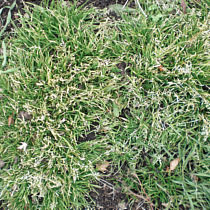Annual Bluegrass is commonly referred to as Poa (Poa annua L.), is one of the most problematic lawn weeds. A winter annual – and sometimes perennial – grassy weed that grows vigorously in moist, cool, shaded conditions and tolerates compacted soils.
It can be a problem in home lawns, especially where it is able to form large patches in wet, shady areas. These patches will then die and leave bare spots when the weather turns hot and dry.
Poa is one of the most common weeds of highly maintained turfgrasses – sports fields and golf courses – giving golf course superintendents headaches when it invades their greens. It tolerates the short mowing heights – forming seed heads that disrupt the uniformity and the ball roll of golf course greens.
Annual Bluegrass Weed ID
- Bunch-type to stoloniferous growth habit.
- Leaf blades are smooth with boat-shaped tips.
- Light green color.
- Leaves often have a wrinkled segment mid-blade.
- Leaves are folded in the bud.
- Auricles are absent.
- Ligule is white and membranous.
- Leaf sheaths are flat and smooth.

Life Cycle and Cultural Charateristics
- A cool-season or winter annual.
- Thrives in moist, cool weather.
- Dies in hot, dry summer weather.
- Forms dense bright green patches.
- Produces seed heads throughout the growing season.
- A native of Europe that is found worldwide.
- Each plant produces about 100 seeds.
- Annual bluegrass is one of the five most widely distributed plants in the world.
- There are actually two types of annual bluegrass – Poa annua var. annua is a true annual and Poa annua var. reptans is a perennial. But it can be hard to distinguish between the two.
Weed Images

Poa is a winter annual (sometimes a perennial) that grows vigorously in cool, moist, shaded areas and on compacted soils.
This picture was taken in my vegetable garden in early October. Check out the picture below that was taken on January 6th.

A fine-bladed, bright-green, low-growing grass with boat-shaped leaf tips. It produces many whitish seed heads.
It only takes a few plants to become established in turf or ornamental areas because it spreads very quickly.

Annual bluegrass forms dense patches that can withstand low mowing heights – making it troublesome on golf course fairways and greens. These patches may suddenly die out in hot dry weather leaving bare patches.

This picture shows the wrinkled section that is often found mid-leaf.

Photo of Poa annua courtesy of Robert H. Mohlenbrock. USDA SCS. 1989. Midwest wetland flora: Field office illustrated guide to plant species. Midwest National Technical Center, Lincoln. Courtesy of USDA NRCS Wetland Science Institute.

Illustration of Poa annua courtesy of USDA NRCS. Wetland flora: Field office illustrated guide to plant species. USDA Natural Resources Conservation Service. Provided by NRCS National Wetland Team, Fort Worth, TX.

A clump of Poa was found in my vegetable garden on the 6th of January. These plants germinated in late September.
Management and Lawn Weed Control
Stop – or at least slow – annual bluegrass invasions by maintaining a healthy lawn. This will provide competition that will slow or prevent Poa annua establishment. Overseeding in the fall with desirable grass types and seeding bare areas will also provide competition for emerging weed seedlings.
When Poa invades your lawn, it is definitely a difficult weed to control and eradication is almost impossible. A good strategy is to manage the population to a tolerable level rather than attempt to eradicate it from your lawn.

Cultural Weed Control Options
Reduce soil compaction by core aerating – but not during the peak annual bluegrass germination times because core aeration will actually encourage the germination of weed seeds.
Water infrequently and deep – if you are over-irrigating, you are creating a wet soil that is going to be more favorable for this weed.
Mow high and frequently – if you are mowing too low, then you are creating a situation where weed seeds will get enough light to germinate.
Overseed, in combination with aeration, every year to maintain a thick lawn that will choke out weed seeds.
Chemical Weed Control
As always, read and follow label directions if you choose chemical control.
The best chemical control option is to apply a pre-emergence herbicide in early fall – before weed seeds germinate. However, if you apply preemergence in the fall, you will not be able to overseed.
Post-emergence herbicides are not an effective control for annual bluegrass in home lawns. There are chemicals – mainly growth regulators – that are used on golf courses to limit the growth, seed production and spread of annual bluegrass. These chemicals are usually labeled for commercial use only and are not practical for weed control in home lawns.
Natural Weed Control
Corn gluten meal can be used as a natural organic weed control. It acts as a pre-emergent herbicide and has the added benefit of being 10% slow-release nitrogen – a natural “weed and feed“.
However, corn gluten meal is finicky, expensive and hard to find.
You might like these
Corn Speedwell | Veronica Arvensis | Lawn Weed Identification
Corn Speedwell (Veronica arvensis) is a low-growing winter annual and a common weed problem in thin turf stands and newly seeded lawns. Pictures to help with lawn weed identification and control.
Mouse-Ear Chickweed | Lawn Weed ID & Control
Mouse-ear chickweed is a common lawn weed found throughout the United States. Its characteristics make it a competitive weed in lawns.
Common Chickweed | Lawn Weed Identification and Control
How to identify and manage Common Chickweed (Stellaria media), a winter annual lawn weed. Photos are included to help with weed ID and control. Lawn care tips and advice.
